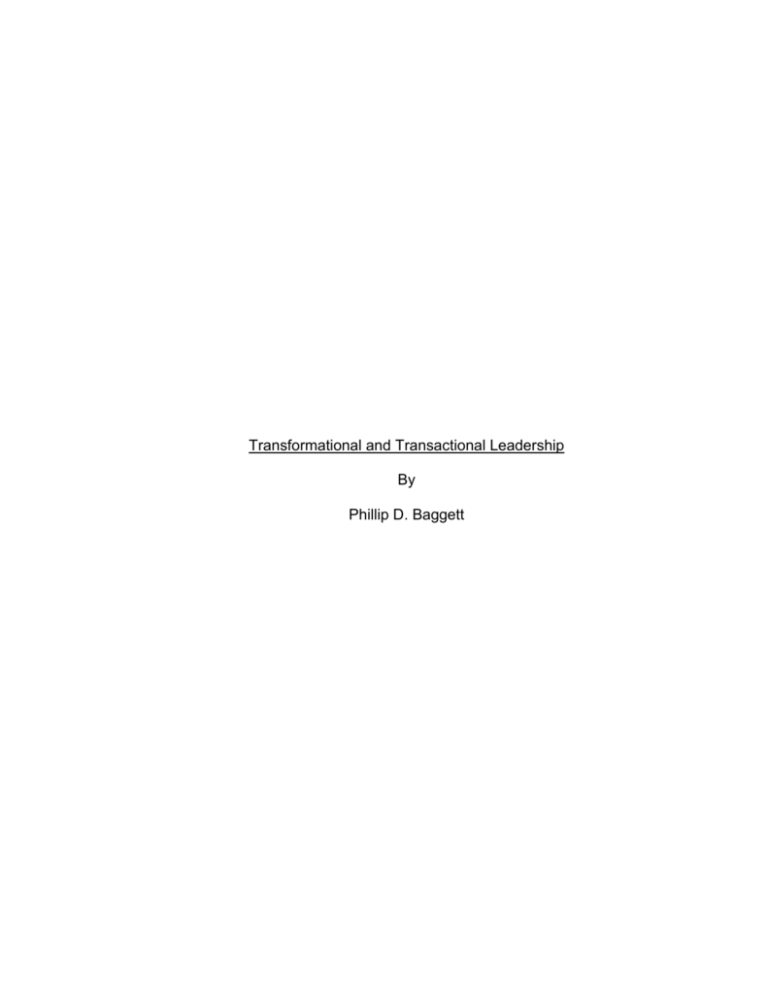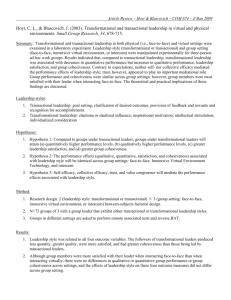
Transformational and Transactional Leadership
By
Phillip D. Baggett
Abstract
In today’s society, leadership: whether personal or impersonal makes all the
difference in the way an organization is structured. This paper will describe and discuss
two different types of leaderships along with their characteristics. This review paper
compares and contrasts transactional and transformational leadership. It focuses on the
leadership styles of transactional and transformational leadership, the characteristics of
style, as well as the similarities and differences associated with leadership behavior.
Leadership is currently one of the main areas of study by researchers and many
philosophers. A number of books, articles, and research papers are written on
leadership such as John Kotter’s “Leading Change”, “One Minute Manager” by Spencer
Johnson and Kenneth H. Blanchard, and “The Leadership Imperative: Making Your
Leadership Your Life” by Brent Fison. Although there are several different leadership
styles, transformational leadership and transactional leadership are two specific styles
examined extensively in the literature. Because all organizations consist of leaders and
followers the question of what differentiates them from one another is of interest. This
paper focuses on the leadership styles of transactional and transformational leadership,
the characteristics of style, as well as the similarities and differences associated with
leadership behavior.
Since Burns (1978) coined the term’s transformational and transactional
leadership, it might be useful to look at his definitions on leadership in general. Burns
wrote, “I define leadership as leaders inducing followers to act for certain goals that
represent the values and the motivations-the wants and needs, the aspirations and
expectations-of both leaders and followers.” (Burns, 1979 pg 183). The leader is not
merely exercising power, but appealing to the values of the follower. In this sense,
values means, “A principle, standard, or quality regarded as worthwhile or desirable,”
(Webster’s New Riverside University Dictionary, 1985, p 536). Burns insists that for
leaders to have the greatest impact on there followers they must motivate followers to
action by appealing to shared values and by satisfying the higher order needs of the
followers, such as their aspirations and expectations. He said, “. . . transforming
leadership ultimately becomes moral in that it raises the level of human conduct and
ethical aspiration of both leader and the led, and thus it has a transforming effect on
both.”(pg 306)
Leadership style plays a crucial role in the development of an organization.
Transactional leadership is of the leadership style that is often used by many
companies. Transactional leadership believes that punishment and rewards motivate
people. This leadership also assumes that when people agree to do a particular
assignment, a part of that agreement is that they give up all authority to their boss. The
leader holds control and power over the subordinates. The main goal of the employee is
to obey the orders of their managers. The idea is that when a subordinate takes on a
job, he or she agrees to obey their manager. The transaction is money or any other
award that the company pays to its subordinates for their compliance and effort. The
relationship between the subordinate and the leader becomes transactional. In
transactional leadership the leader has the right to punish his or her subordinates if their
performance is not according to the predetermined standard.
In transactional leadership, when the leader assigns work to his or her
subordinates, then the subordinate is responsible for seeing that the assigned task is
finished on time. If the assigned task is not completed as defined then punishment is
given for the failure. But if the employee accomplishes the task in time then the
subordinates are given reward for successfully completing the task. Subordinates are
also given award and praised for exceeding expectations. A subordinate whose
performance is below expectation is punished and some action is taken to increase his
or her performance.
Transformational leadership is about implementing new ideas; these individuals
continually change themselves; they stay flexible and adaptable; and continually
improve those around them. A transformational leader focuses on transforming others
to help each other, to look out for each other, to be encouraging and harmonious, and to
look out for the organization as a whole. With this leadership, the leader enhances the
motivation, morale and performance of his followers through a variety of mechanisms.
These include connecting the follower's sense of identity and self to the mission and the
collective identity of the organization; being a role model for followers that inspires them;
challenging followers to take greater ownership for their work, and understanding the
strengths and weaknesses of followers, so the leader can align followers with tasks that
optimize their performance.
Several personal leadership characteristics are essential for a leader to possess
in order to effectively lead and transform an organization. These personal
characteristics describe the aspect of leadership better known as transformational
leadership, leadership that seeks to transform not only the organization but also the
followers' vision of "what is" to "what can be". The following highlights four
characteristics that leaders exhibit when effectively leading organizational
transformations. One of the first personal characteristics that a transformational leader
must possess is confidence and a belief in their own abilities to truly influence and
change the present course and action of an organization. Effective leaders are able to
purposefully inspire and energize people to act in a direction towards a goal they have
helped them understand is worthy and meaningful. Therefore, the transformational
leaders must possess the ability to create and communicate a powerful vision that will
excite the minds of their followers, inspiring them to go beyond their current boundaries.
Developing and communicating the vision is just the beginning. An effective
transformational leader must also be able to continually sell the vision, and continually
convince others to climb on board, stick it out, whether in good times or bad. How a
leader frames the future and the organizations' purpose is critical for long-term support.
Finally, three additional characteristics that are essential for being a transformational
leader include being a change leader, an innovator and an effective coach.
Leaders vary from one another in how they work collaboratively toward a shared
vision. What’s more, the same leader may use a variety of different leadership
behaviors and techniques to effectively work with others. Bernard Bass, points out the
relationship between transactional and transformational leadership. “The best
leadership is both transformational and transactional. Transformational leadership
augments the effectiveness of transactional leadership; it does not replace transactional
leadership, (Walsman, Bass, & Yammarino, 1990).” Transaction continues to be an
effective tool, and a necessary tool, for leaders at all levels. Transformational leaders,
whose choice would be to gain agreement by appealing to the values of the followers or
peers, finding the road blocked, may resort to the transactional style. “When the
transformational leaders sees himself/herself in a win-lose negotiation he tries to
convert it into a win-win problem solving situation. If this is not possible, then he or she
can display the transactional skills necessary as an effective negotiator, (Walsman,
Bass, & Yammarino, 1990).” Both leadership behaviors are appropriate and important
approaches through which leaders can motivate others. In some instances, a leader
may need to use a more give-and-take approach. At other times, the same leader may
decide that he/she shares more than just a common interest with followers and may
seek to build upon shared values, morals, and vision to achieve a new goal.
The difference between transactional and transformational leaders lies in their
process of motivating followers. Transactional leaders begin with established goals or
directives of their company and motivate employees to pursue these directives by
“clarifying role and task requirements” (Robbins, 2005: 367) through rewards or
intervention if standards are not met. Basically, they employ a hands-off management
style, but step in when they recognize that goals are not being attained.
Transformational leaders focus on stimulating, motivating, and empowering their
employees to achieve company directives. They do this by “ appealing to higher ideals
and moral values” (burns, 1978). Basically, they employ charisma and proactive
communication to inspire employees to excellence, but charisma isn’t the crowning trait,
it’s merely a helping tool to generate excitement to excel and achieve profound results
that appeal to higher, external ideals. And through personal example, transformational
leaders serve as beacons to the possibility present in higher goals.
Transactional leadership is not long term. It is short term. The key word here is
transactions! The leader does not expect any return business with the people he is
dealing with. A transactional leader is aware of the link between the effort and reward.
They are responsive and its basic orientation is dealing with present issues.
Transformational leadership, on the other hand, is a very different kind of leadership. It
takes into account the motivation and the situation of the followers and subordinates. It
primes up people for repeat business and continuous improvements. Transactional
leadership is typically employed for hiring faculty, allocating resources, salary
adjustments, promotions/tenure actions, counter offers, problem employee
interventions, and academic governance. Transformational leadership is appropriate for
strategic planning, cutback management, task forces for problem solving,
leadership/professional development, requests for proposals, and grievance resolution.
In conclusion, people with transformational leadership styles are true leaders
who inspire their teams constantly with a shared vision of the future. While this leader's
enthusiasm is often passed onto the team, he or she can need to be supported by
"detail people." That's why, in many organizations, both transactional and
transformational leadership is needed. The transactional leaders ensure that routine
work is done reliably, while the transformational leaders look after initiatives that add
value. There is no right or wrong style of leadership to be used in an organization. What
matters is how you use one style of leadership to accomplish your goals as a leader.
References
Bass, B. M. (1990). Bass & Stogdill's Handbook of Leadership. (3 ed.) New York:
Free Press.
Bass, B. M., Avolio, B. J., Jung, D. I., & Berson, Y. (2003). Predicting Unit Performance
by Assessing Transformational and Transactional Leadership. Journal of Applied
Psychology. 88 (2), 207.
Bono JE, & Judge TA. (2004). Personality and transformational and transactional
leadership: a meta-analysis. The Journal of Applied Psychology. 89 (5), 901-10.
Burns, J.M. (1978) Leadership. New York, NY: Harper and Row.
Robbins, S. P. (2005). Essentials of organizational behavior. Upper Saddle River, N.J.:
Pearson/Prentice Hall.








